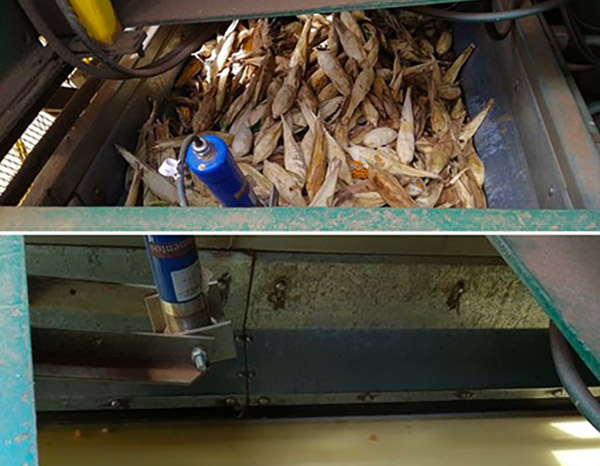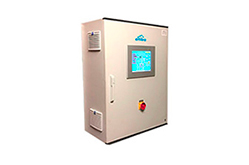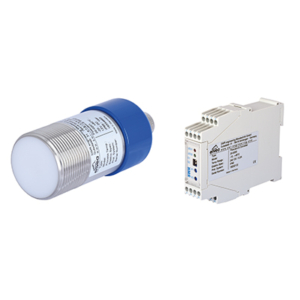
APPLICATION
Our customer in agriculture industry transports corn cobs via a conveyor belt. He was looking for an easy to install and maintain solution to monitor whether material flows on top of their conveyor belt. With this information more control and automation as well as an exchange of information with the upstream and downstream process is possible.
SOLUTION
Contactless material flow detection can be achieved thanks to the Microwave technology. Such installation allows durability and no damages in the sensor.
Installed over the conveyor belt, the sensor has no material contact ensuring no wear or breakage.
With the material flow information, the automated system is able to associate with related processes and make the whole batch work more smoothly and integrated.
CUSTOMER BENEFITS
- Energy efficiency, because subsequent units only need to be switched on when the sensor indicates material on the belt
- Information exchange with the truck unloading (before) and sieve (after) possible
- Long durability, no material contact
- Very easy installation and adjustment
RELATED ARTICLE – Moving Bulk Solids using Conveyor Belts
Conveyor belts are one of the biggest revolutions of the 19th century that changed the idea of material movement forever. The initial use of conveyor belts can be dated as far as 1892 when they were used to move coal and ores out of mines. This single invention brought a drastic increase in mining profits due to a decrease in labor costs and a significant increase in throughput.
From that point on, conveyor belts were rapidly adopted in all scenarios where bulk movement of material was required. Common everyday examples of conveyor belts that almost everyone is accustomed to are escalators, moving walkways, baggage carousels at the airport, and check-out counters at supermarkets. Far from these, conveyors are considered a lifeline for almost every industrial and warehouse setting.
The most basic conveyor belt design comprises two or more powered pulleys connected to a motor, whose rotation results in synchronized movement of a belt that is tightly wound around the pulleys. This results in a single direction, looped movement of the belt which helps in transporting the material on top from one pulley to the other. However, not all conveyors share this design, and based on the application, some conveyors may be designed to cater to the need of transporting a specialty bulk product, such as the use of air conveyors in bottle manufacturing plants. Therefore, conveyor belts are commonly defined based on the carrying medium used to move the material.
Without prejudice towards the carrying medium (belt or air) used, material movement on conveyors requires continuous monitoring for safety, capacity for storage at end point, product health, especially in the case of food items, quality, and reliability. Modern conveyors, therefore, use suitable instrumentation to record real-time data, which is input in a control module, that processes it and executes adequate action based on programmed situations. Examples include weight measurement on baggage carousel or quality control to identify defective plastic bottles that are simultaneously rejected and removed while moving along the air conveyor.
Examples of conveyors are also widely observed in the food industry, where commercially sold products are prepared as well as packaged without leaving the conveyor at any point. This is a mandatory requirement posed by many food authorities to restrict human intervention in the process to ensure high levels of hygiene and quality control. Food products in general are variable in type and size. While at the same time, to maintain uniformity, food products are commonly sold in standard packaging of defined mass or volume. This makes the job more challenging since it is almost impossible to record and observe each food item manually especially in a mass production setting where product flow is tons/hour. To ensure correct mass of the final product, volume flow measurement is conducted using mass flow meters.
The mass flow meters emit microwaves towards the product and evaluate changes in frequency and amplitude as it passes through the pipe during the measurement process. The measurement process is based on the Doppler effect. This allows for contactless in-situ (online) real-time monitoring of product flow. The data from the flow meter is then fed on to a controller using a feedback loop which makes appropriate decisions to start, pause or stop product flow. Good quality mass flow meters can easily record mass flows between 10 t/h to up to 300 t/h accurately and restrict contamination due to dust or erosion. This makes the overall process extremely clean and especially suitable for applications where contamination is not an option. Depending on the product type, mass flow meters may additionally be used with moisture measurement or particle size measurement meters to record changes in the product flow and quality overtime.
These examples show that conveyor belts have come a long way from their initial use in mining. The modern-day conveyors are strong, smart, and precise in their work and with new developments taking place even after two centuries, conveyor belts are here to stay.
John – February 1st, 2021
Contenuto relativo
Richiesta di informazioni


